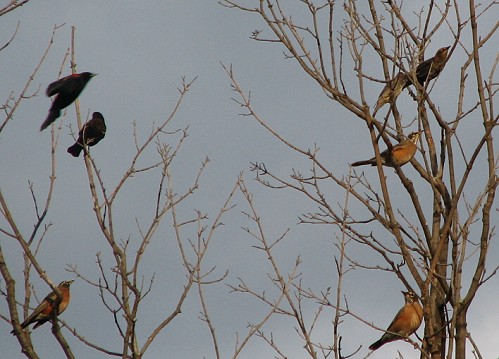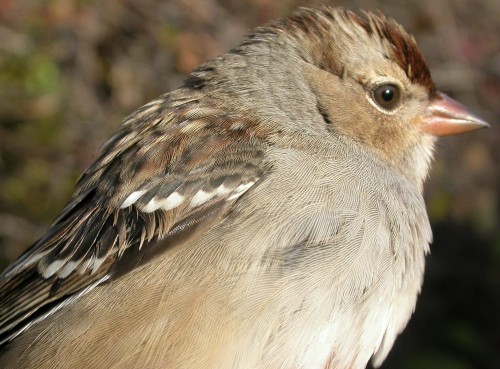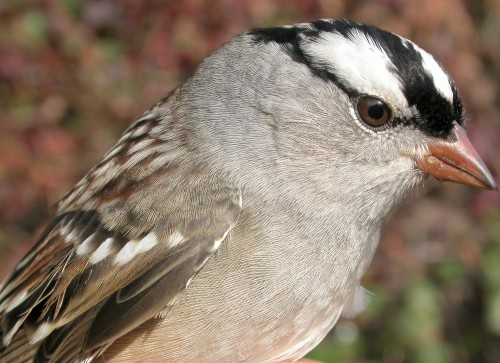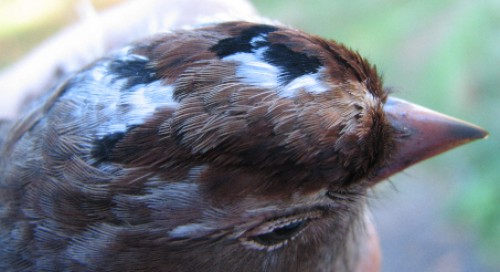|
Week 10: October 3-9, 2006 |
Welcome
to the McGill Bird Observatory weekly report.
Click here for a complete listing of our archives.
Comments or
questions are welcome at "mbo AT migrationresearch.org".
|
PICTURE
OF THE WEEK: |
|

This week, species banded for the first time
this season included Brown Creeper and
the Fox Sparrow shown above. This is among the few
species that is likely to become
increasingly common over the final three weeks of the
season, usually dominated
by American Robins and a variety of sparrow species.
(Photo
by Barbara Frei)-
|
 |
MBO
gratefully acknowledges the financial support
provided for the 2006 Fall Migration Monitoring
Program by Mountain Equipment Co-op's
Environment Fund |
|
|
|
THIS WEEK |
THIS FALL |
2006 TOTAL |
SITE TOTAL |
|
# birds (and species) banded |
305 (23) |
2612 (72) |
3547 (82) |
8600 (96) |
|
# birds (and species) repeat |
26 (11) |
323 (33) |
560 (39) |
1438 (52) |
|
# birds (and species) return |
1 (1) |
24 (9) |
121 (22) |
190 (26) |
|
# species observed |
65 |
131 |
159 |
180 |
|
# net hours |
333.3 |
3587.3 |
6699.1 |
13121.2 |
|
# birds banded / 100 net hours |
91.5 |
72.8 |
52.9 |
65.5 |
|
|
Note: table does not include nocturnal banding (owls) |
Bander-in-charge:
Barbara Frei
Assistants:
Nadege
Allan, Jean Beaudreault, Sophie Cauchon, Dominic Chambers, Natalia
Costella, Jacinthe Daprato, Alejandro Del Peral, Jean Demers, Maria
Frei, Gay Gruner, Amy Henderson, Keelan Jacobs, Marie-Pier Lambert,
Sarah Marteinson, Poonam Maskeri, Laurie Maurias, Mike Mayerhofer,
Betsy McFarlane,
Anthi
Mimidakis, Chris Murphy, Annie-Claude Paradis, André Pelletier, Greg
Rand, Sabrina Richard-Lapland, Katleen Robert,
Marie-Claude Roy,
Clémence Soulard,
Katie
Sullivan, Rachel Verkade, James Young
Notes:
This
week was slower in bird activity than the past week. Several mornings
were rather frosty, leading to some stiff and frozen nets and fingers.
The busiest day was a very foggy Wednesday morning (4th Oct.)
with 109 birds banded from just two net lines. This was due to a large
wave of Ruby-crowned Kinglets, which resulted in them overtaking Yellow-rumped
Warblers as the most frequently banded species of the week.
Despite
the lower number of birds banded there were 6 new species sighted in
Week 10. These included the previously mentioned Brown Creepers and Fox
Sparrows banded this week. In addition, a Rough-legged Hawk was seen
soaring above late Wednesday morning once the skies cleared. Early
Thursday morning a Snow Goose was spotted among one of the growing
Canada Goose flocks. It was distinguished from the surrounding Canada
Geese by its smaller size and lighter body with dark tipped wings. As
well, during the Thursday census a lone Eastern Bluebird was heard
singing its bittersweet farewell amongst the rowdier chatter of American
Robins. Lastly, a curious juvenile Northern Shrike supervised the
de-frosting of the A net on a the chilly Saturday morning – but despite
our most polite invitation it did not enter the net once it was opened.
Perhaps next time!
|

It seems there are always birds in the large dead tree near the
north end of Stoneycroft Pond, and it's always a good idea to
look closely at them for potential surprises. Can you spot
the four species in the photo above? Answer at the end of
this week's report. (Photo by Barbara Frei) |
With
the ripening of the buckthorn berries and wild grapes on site has come
the time of the American Robins, whose chatters and songs fill the
morning air. Several found their way into the nets and dyed both our
bags and volunteers hands a rather lovely shade of blue with their
berry-filled droppings. Their smaller and infinitely better behaved
cousin, the Hermit Thrush, was also a welcome visitor most mornings. A
surprise in this week’s top 10 banded is the Winter Wren. These little
songsters are often tricky to see, so it’s a treat to have a good number
of them in the nets this week.
This
week's top 10 [last week's rank in
brackets]
|
# individuals banded |
mean # individuals
observed daily |
|
Ruby-crowned Kinglet (115)
[2] |
Canada Goose (376)
[1] |
|
Yellow-rumped Warbler (40) [1] |
American Robin (99)
[6] |
|
White-throated Sparrow (31)
[3] |
American Crow (67)
[2] |
|
American Robin (28) [-] |
Red-winged Blackbird (57)
[-] |
|
White-crowned Sparrow (17)
[4] |
Ruby-crowned Kinglet (49)
[4] |
|
Song
Sparrow (10)
[6] |
White-throated Sparrow (25)
[5] |
|
Hermit Thrush (10) [-] |
Yellow-rumped Warbler (25)
[3] |
|
Golden-crowned Kinglet (7)
[5] |
Blue
Jay (23) [7] |
|
Swamp Sparrow (7) [-] |
Common Grackle (22)
[-] |
|
Winter Wren (6)
[-]
|
Black-capped Chickadee (17)
[9] |
|
At this point last year,
White-throated Sparrows had been on top of the list of most frequently
banded birds for four consecutive weeks. This year they are much
less abundant, consistently within the top five, but never yet cracking
the top two - are they just late, have they been passing MBO by this
year, or did they have a poor breeding season compared to 2005?
Questions such as these are difficult to answer at this point, but once
we have several more years of consistent monitoring behind us, yearly
fluctuations and population trends should become more apparent.
The top 6 species from
last week's banding list remained in this week's top 10, while the
American Robin vaulted into fourth place and will likely remain among
the most abundant species over the final three weeks of the season.
White-crowned Sparrows continue to be surprisingly numerous, with more
banded in the past two weeks (44) than in the cumulative history of MBO
to this point (39).
The
Canada Geese dominated this week’s list of top 10 seen. in
addition to a substantial increase in American Robin numbers, a big
change from last week is the growing number of Red-winged Blackbird
flocks passing through. They rarely if ever come low enough to be caught
in the nets in the fall – but they often land in some of the larger
trees in the property, causing a competition for space and sound with
the feeding American Robins. And it's often worth to take a closer look
at these groups, for many days this week we were able to spot several
Rusty Blackbirds among them.
|

The confusing fall warblers may be largely past us at this
point, but this does not mean there are no challenges remaining.
Sparrows are often regarded as a confusing bunch - more so when
they do not look as expected. The large sparrow above has
tricked many. However, if you look closely at the bill and
facial pattern, it is very similar to that of the bird below,
easily recognizable as a White-crowned Sparrow. In fact,
while the plumage above can be confusing at first, its
distinctiveness makes this the easiest of the sparrows for which
to distinguish between hatch-year (above) and after-hatch-year
(below) birds. (Photos by Marcel Gahbauer)
Occasionally, there are hatch-year White-crowned Sparrows that
are already showing a bit of white and black in their crown,
like the individual below captured this week.
(Photo by Barbara Frei)
Answer to the
4-species photo: 2 Red-winged Blackbirds (top left, one
showing its red shoulder patch), 3 American Robins (all easily
spotted by their orange breasts), 1 Rusty Blackbird (top right,
with a visibly brown tone, especially around the face, and the
yellow eye barely showing), and 1 Cedar Waxwing (a streaky
hatch-year bird just below and to the left of the Rusty
Blackbird):

|






